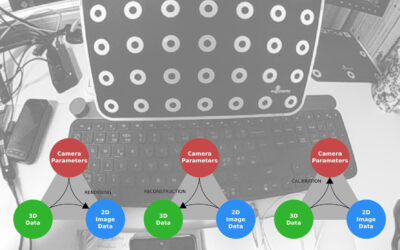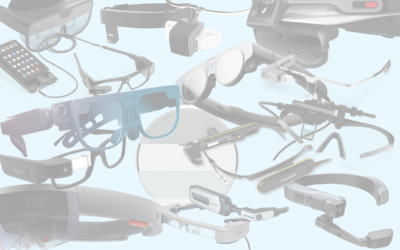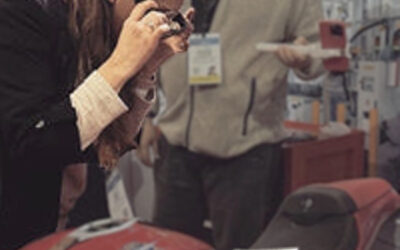
Unveiling the Magic Behind Augumenta’s AR accuracy: Camera Calibration in Smartglasses
Introducing camera calibration and its importance in high-accuracy augmented reality

The eye box is the secret behind good AR UX. Discover what it is and how to take full advantage of this hidden smartglasses spec
Specifications such as resolution, brightness, battery life and weight/bulk are all what people talk about when comparing smartglasses. So how is it that a glass like the HMT-1, which excels in every one of those points (except maybe the weight), still gets comments from users like “it’s really hard to see the picture”, “the device is moving too much on my head”, “I can’t see the display anymore” or “I need to readjust the glasses all the time”?
The source of these complains is a dirty little secret that no manufacturer talks about: the “eye box”. Never heard of it? Read on!. The eye box is the volume in front of the smartglasses display within which the eye must be positioned in order to see the full display image.
Think of it this way: if you look at a screen through a long pipe you will have to put your eye right in front of the pipe to see the entire display. If your eye moves a bit left or right the pipe will start to obstruct your view of the display. Thus the eye box will be small. The TV in your living room, on the other hand, has a huge eye box, possibly the size of the entire room. But again, put a few pieces of cardboard around the bezel of the TV and now you have a much reduced space from which the entire TV can be seen.
For smartglasses this parameter is the most critical because glasses naturally move a little on our heads, and our eyes themselves are also not static. If you need to readjust the display position every two minutes because the glasses has moved a little, then the user experience will be in the “throw that device in the bin” category. On the other hand, if you can forget about your glasses once they’re on your head and be sure the display will always be visible, then you do have a true hands-free experience and your workforce will accept and enjoy the advantages of smartglasses. As will your company bottom line.
Better resolution only marginally improves UX. Battery life can be extended with hot-swappables or external packs. Luminance is not critical with opaque displays. Weight is usually manageable especially when mounted on helmets. But if you can’t see the display properly unless you readjust it all the time, then your project is toast.
Another important aspect of the eye box is related to the inter-pupillary distance (IPD). Head morphologies changes from person to person, from race to race, from age to age. A classic example of device with issues is the Epson Moverio smartglasses: designed with a larger inter-pupillary distance in mind, it is well adapted to the Asian market. But people with more narrow heads and thus smaller distance between their eyes will experience display visibility issues. Ask me how I know: I’ve used Epson devices for more than 10 years and I have never been able to fully see both left and right displays at the same time. The Moverio has small eye boxes, so that if the IPD of the user doesn’t match the one of the glasses then at least one eye will be out of the eye box and won’t see its display properly. Therefore this issue is not only important for monocular, assisted-reality models like the HMT1 (Realwear), the H1 or G2 (Iristick) or the M400 and Blade from Vuzix. It’s also very important for full AR binocular models. And indeed, recently we started to see one or two smartglasses with variable IPD to alleviate the problem. Great!
However with optics everything is a trade-off. Another important optical parameter of smartglasses is their field of view (FoV), which is unfortunately linked to the eye box. This connection creates a substantial challenge in designing smartglasses that offer both an expansive FoV and a large and comfortable eye box.
If you have a chance, do try a Vuzix M400 and an Realwear HMT-1 side-by-side. The Realwear is of course sturdier and has a more flexible display arm. But you will also now notice the larger eye box of the M400 that makes display positioning less critical and how much more comfortable it is to use in the end. Armed with that knowledge, go ask the question to your vendors and educate them about what the eye box is if necessary: their designers know about it of course, but maybe not their sales teams. Your users will thank you for it!
And so why is no one talking about it? Simple: it’s not a straightforward specification, takes time to explain, and often involves comparing devices from competing manufacturers. The latter being something manufacturers’ sales teams will be a little reluctant to do 😉 However at Augumenta we are vendor-agnostic and we are not afraid of pitching one device against another. With us you get deep and unbiased professional advice based on years of experience to make your smartglasses projects a successful reality. Do get in touch!

Introducing camera calibration and its importance in high-accuracy augmented reality

How hundreds of millions can be saved every year by large logistics operations thanks to smartglasses and SmartMarkers.

How millions can be saved every year by introducing SmartPanel and smartglasses to reduce airframe weight, shorten idle time and shrink ground crews.

Standard QR codes are poor candidates for professional smartglasses use cases as they were designed for hand-held scanners, not head-mounted cameras. What you can do about it?
